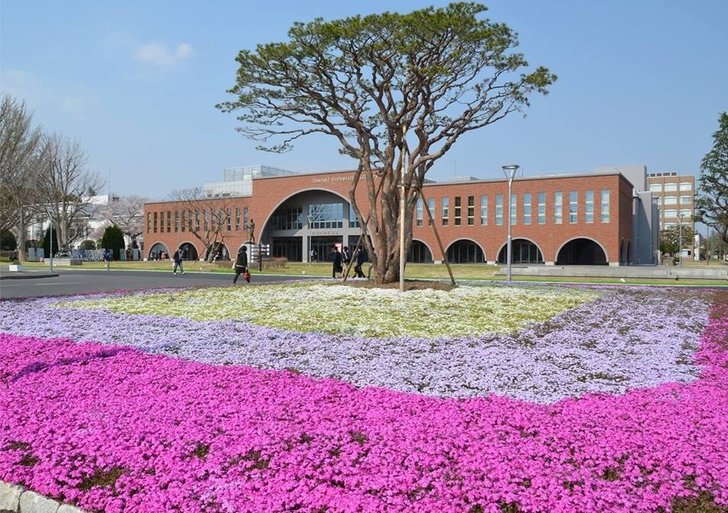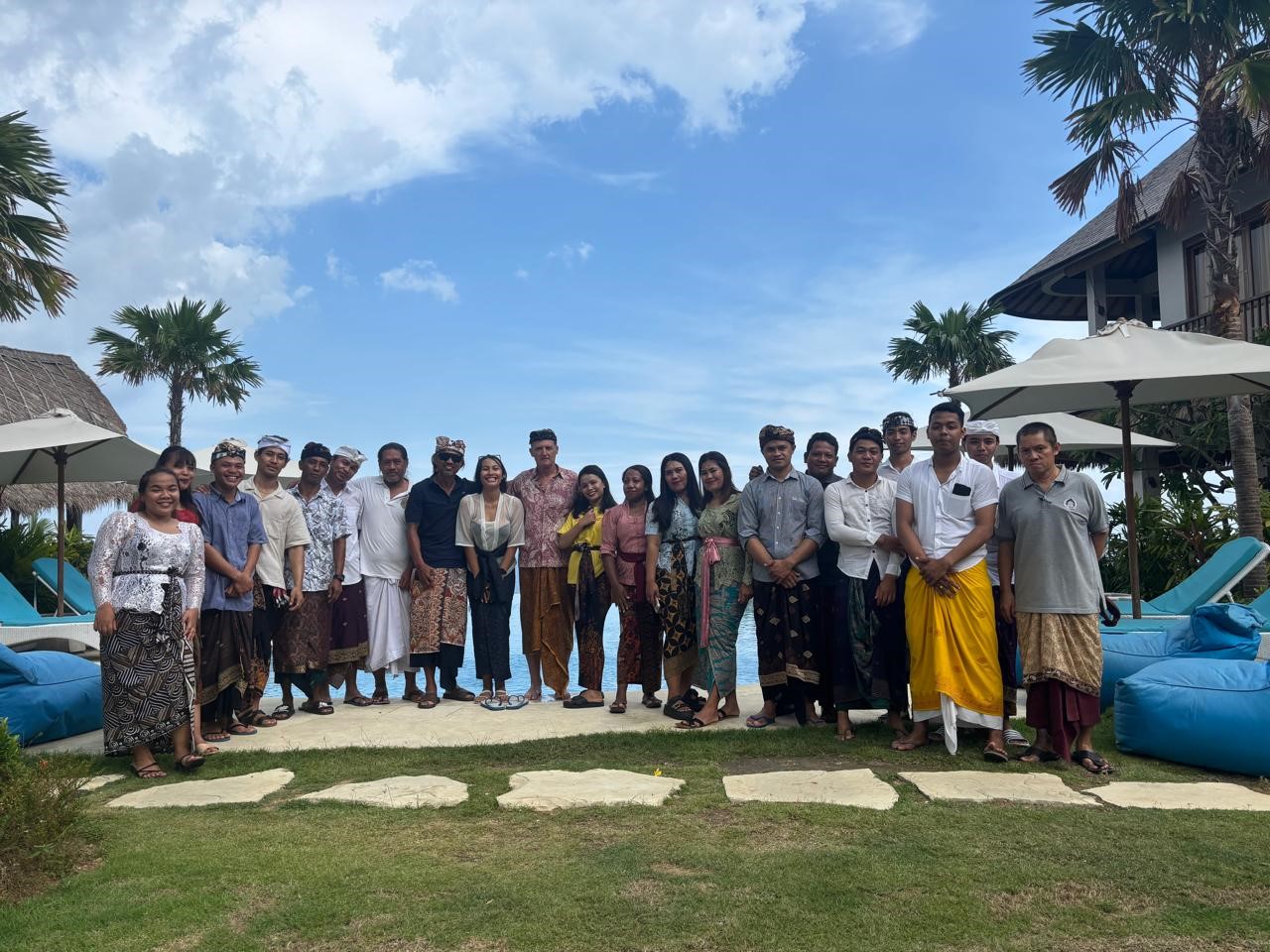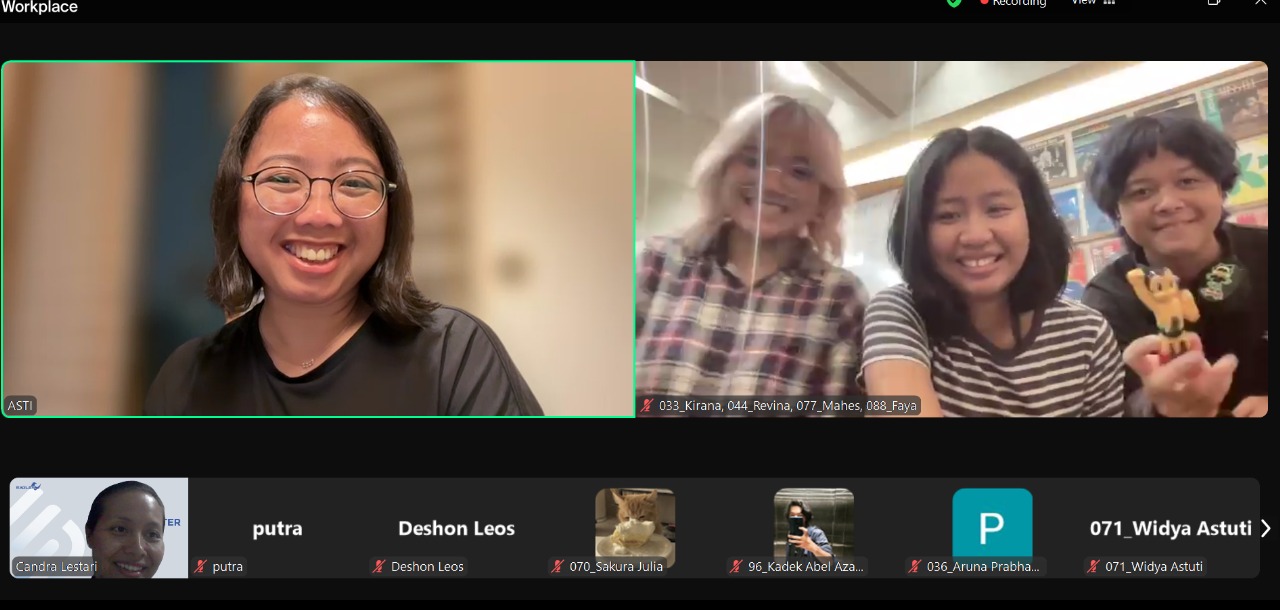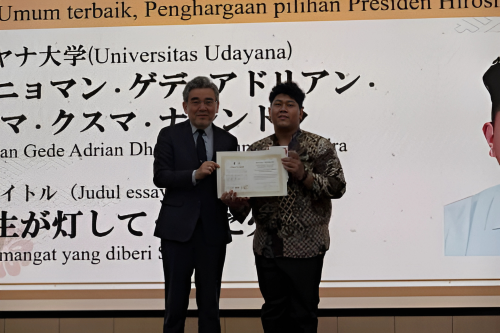2018 Ibaraki University Exchange Program by Adre Zunara
I am Adre Priatama Zunara, a 2015 student of the Japanese Literature Study Program, Faculty of Humanities, Udayana University. On this occasion, I would like to share my experience as a ryugakusei (exchange student) at Ibaraki University.
Overview

Ibaraki University is located in Mito city, Ibaraki Prefecture, Japan. Ibaraki itself is located in the Kanto region, still in the same area as the Japanese capital, Tokyo. The journey from Mito Station to Tokyo Station takes approximately 2 hours by densha (electric train) and approximately 4 hours by bus. Besides Mito Campus, Ibaraki University also has two other campuses, namely Ami Campus and Hitachi Campus.

Mito City is famous for its specialty, natto. Natto is a traditional Japanese food in the form of fermented soybeans. Natto has a very distinctive and unique taste that no other food in the world has. In general, natto is eaten as an okazu (side dish) by local people, but natto can also be eaten as breakfast or a snack.
Preparations Before Departing for Japan
After receiving a certificate of eligibility (a kind of SK acceptance of the ryugaku program) from Ibaraki University, ryugakusei candidates are required to prepare several requirements before leaving for Japan. These needs include:
1. Student visa
Student visas (especially to Japan) can be obtained at the Consulate General of Japan. The requirements that need to be completed to obtain a student visa are passport, original and photocopy of ID card, visa application form, and certificate of eligibility. The cost of applying for my own visa is IDR 330,000.
2. Accommodation costs
This program does not cover any costs other than tuition fees. Therefore, accommodation costs are borne by the ryugakusei candidates themselves. I myself departed in April and at that time in Japan it was the peak of spring, so airline ticket prices were quite high. The average price of airline tickets departing to Japan at that time was around Rp. 7 million.
3. Deposit balance
This program requires ryugakusei candidates to deposit money into a bank account that can be used in Japan. This is intended to ensure that funds are available if something unexpected happens to the ryugakusei in question. The required deposit value is a minimum of 100,000 yen/month. The program I chose lasted 5 months, so the money I deposited in my account was 500,000 yen or around Rp. 65 million.
Residence During Study Abroad
Ibaraki University provides a special dormitory for ryugakusei called Ibaraki Daigaku Kokusai Koryu Kaikan. The cost of living in this hostel is 6,030 yen/month, consisting of a rental fee of 5,900 yen and an admin fee of 130 yen. Other costs, such as electricity, water, and gas, are not included in the cost of living because they are paid for by the occupants themselves. These other costs, of course, depend on the usage of each. The average cost I myself spend is electricity around 1,000-3,000 yen/month, gas around 1,000-4,000 yen/month, and water around 4,200 yen/2 months, including the basic cost of 2,000 yen.
This hostel has fairly complete facilities. The public facilities in this hostel are lounge, coin laundry, TPA, and jidou hanbaiki (vending machine) drinks. The lounge is a kind of living room that is usually used by ryugakusei and Japanese students to carry out various activities, ranging from just using wi-fi to small events such as welcome parties, shokujikai (eating parties together), and so on. Coin laundry is a place for dorm residents to wash their clothes. The washing fee at the coin laundry is 200 yen/1x30 minutes for cleaning and 100 yen/1x30 minutes for drying. In addition, free toilet paper is also provided which can be taken at any time and at any time.
The facilities in the room are also very complete, consisting of furniture (cupboards, tables, chairs, and mattresses), refrigerator, sink, stove, bathroom, and air conditioning. The air conditioner here is also different from the air conditioner in general in Indonesia because in addition to functioning as an air conditioner, it also functions as a humidifier and air heater. The water in the shower can also be set to hot or cold.
Ryugakusei who lives in the dormitory doesn't have to worry if something happens because there are several Japanese students serving as tutors. The tutor in the dormitory serves as a ryugakusei companion if there is a ryugakusei who needs help or assistance. Therefore, the ryugakusei don't have to worry when something happens in the dormitory because the tutors will always be ready to help.
Studying at Ibaraki University
Before starting college, the ryugakusei will take a placement test to determine to which level the ryugakusei will be placed. There are five placement levels for the ryugakusei, namely:
• Level 1 (shokyu zenhan), the lowest level with 6 compulsory courses
• Level 2 (shokyu kohan), second level with 6 compulsory courses
• Level 3 (chukyu zenhan), intermediate level with 7 compulsory courses
• Level 4 (chukyu kohan), fourth level with 5 compulsory courses
• Level 5 (jokyu), the highest level with 3 compulsory courses
These compulsory subjects are subjects in the Japanese category. Some of the courses include dokkai (reading), hyokai (writing), chokai (listening), and so on.
Apart from compulsory courses, ryugakusei are also required to take several additional courses to fulfill the credits received. These courses are courses taken together with Japanese students. Based on the category, the courses are divided into 4 types, namely:
• Classes for advanced level students
• Japanese language, culture, and communication
• Classes conducted in English
• English language classes for students speaking English as a foreign language
Apart from these four categories, actually ryugakusei are also allowed to take other courses in general lectures. However, this is not recommended by the campus because it is too advanced for the Ryugakusei level.
Non-academic Activities at Ibaraki University
Ibaraki University is rich in various non-academic activities. Apart from those organized by the campus, Japanese students also often hold activities through their respective (circle or club, at Unud it can be equated with UKM). There are hundreds of sakura at Ibaraki University, from the English Club to kyudo (traditional Japanese archery). As for some of the activities that I participate in, both those organized by the campus and students, namely:
• Smi?
Smi? is a circle that is active in the Ryugakusei environment. In general, the dorm tutors are also included in this circle because of their closeness to the ryugakusei. In addition to holding small events such as shokujikai and nomikai, Smi? also holds quite large events such as excursions to Hitachi Seaside Park and Tokyo Disneyland.
• Sado and ikebana
This activity is one of the activities organized by the campus. In this activity, we will be accompanied by a lecturer to the house of a practitioner of sado (traditional Japanese tea drinking) and ikebana (traditional Japanese flower arrangement). In this activity, the ryugakusei can learn a lot about sado and ikebana.
• Homestay
This activity is also one of the activities organized by the campus. In this activity, ryugakusei are given the opportunity to stay with a Japanese family for 3 days. Before deciding which family the ryugakusei will be paired with, each ryugakusei will be given a form to find out the likes and dislikes in a family, such as whether or not they can drink sake, whether or not they can live with pets, and so on.
• International Summer Camp
This activity is also one of the activities organized by the campus. In this activity, the participating ryugakusei and Japanese students carried out gasshuku (camping) activities for 2 days 1 night at the foot of Mt. Fuji, to be precise in Gotenba. During the activity there are many and various activities that can be followed, such as trekking, sado, making glass ornaments, bonfires, games, morning sports, barbeques, and many more.
• Mito Komon Matsuri
This activity is an activity organized by the campus in collaboration with the Mito city hall. In this activity, the participating ryugakusei and Japanese students performed the yosakoi dance along the main street of Mito city, precisely around the road near Mito Station. Before the D-day of the activity, all participants were given dance training together for the previous two weeks. Mito Komon Matsuri itself is a festival commemorating the founding of the city of Mito. When this festival was held, many local residents and tourists enthusiastically watched and enlivened it.
• Manabi no Wa
Manabi no Wa is a volunteering activity organized by the campus in collaboration with the neighboring city hall, namely the city of Oarai. In this activity, my shidou kyouin (co-lecturer), Yokomizo-sensei, was in charge. I was invited by him to participate in this activity. In this activity, the volunteers carry out various activities, such as translating pamphlets from Japanese to their respective native languages, teaching Japanese to newcomers from the same country of origin who are not fluent in Japanese, and so on.
The final word…
Several people I know have told me that they really want to try ryugaku in Japan, but almost all of them have one particular reason they can't do it: "fear". Fear here means worry or worry that they will live in a very different environment with people they don't know and even speak very different languages.
From my personal experience, once I got there, I often experienced home sick and missed my hometown. For me, this is something that is natural and must happen to everyone who is living abroad for the first time. The thing that needs to be underlined here is how we overcome it and how we maintain the mindset to move forward and face all obstacles.
Therefore, I advise readers to never be afraid to try something new. By trying new things, we can train ourselves to be more adaptable to new people and environments. Besides being useful for adding insight, it can also provide a new perspective in dealing with something so that the mind is more open to accept something new without having to fear losing one's identity as an Indonesian. For me, the experience of ryugaku in Japan made me appreciate many things about Japan and also Indonesia as my country of origin.
If I can do it, I'm sure you can do it too! Itsumo ganbatte Kudasai!




UDAYANA UNIVERSITY